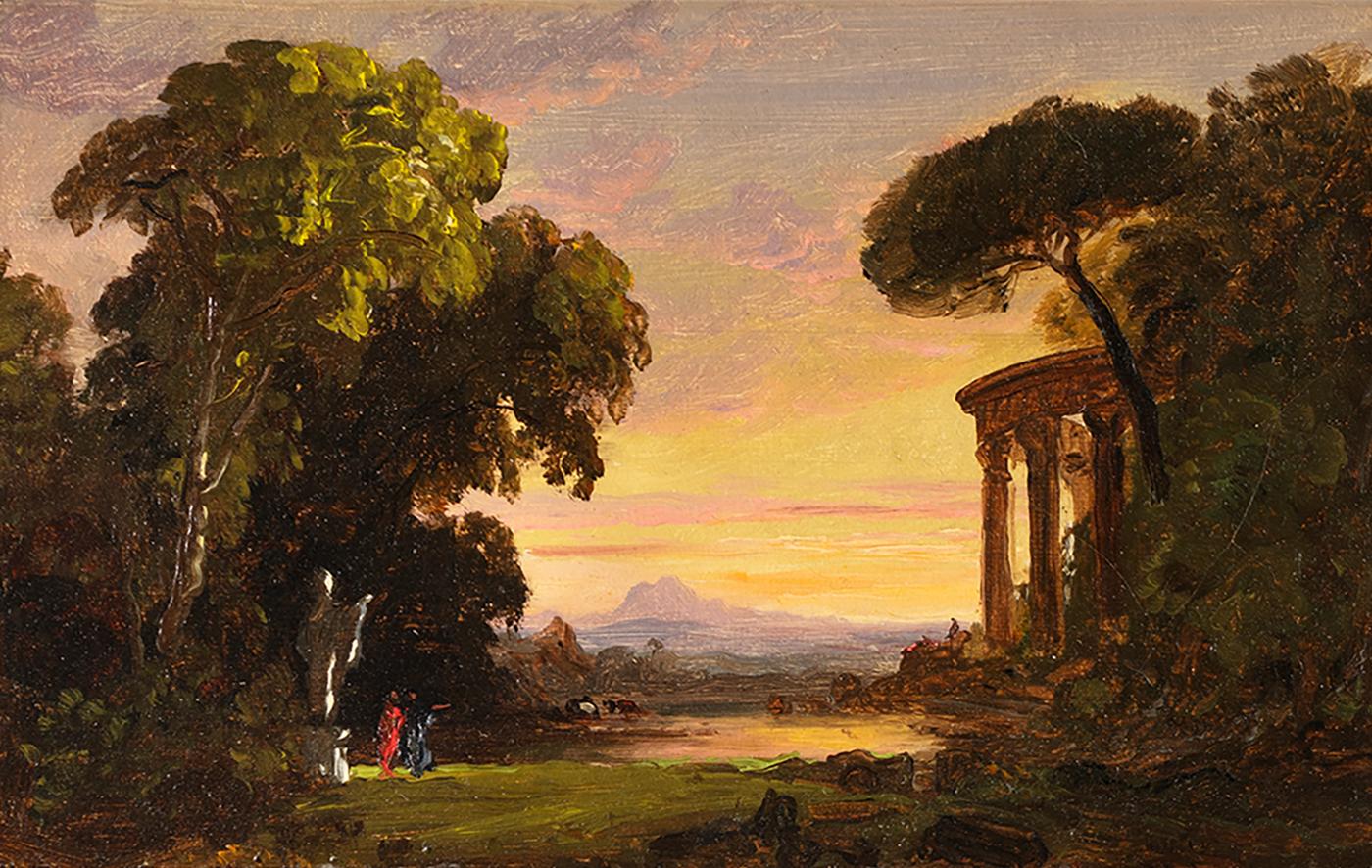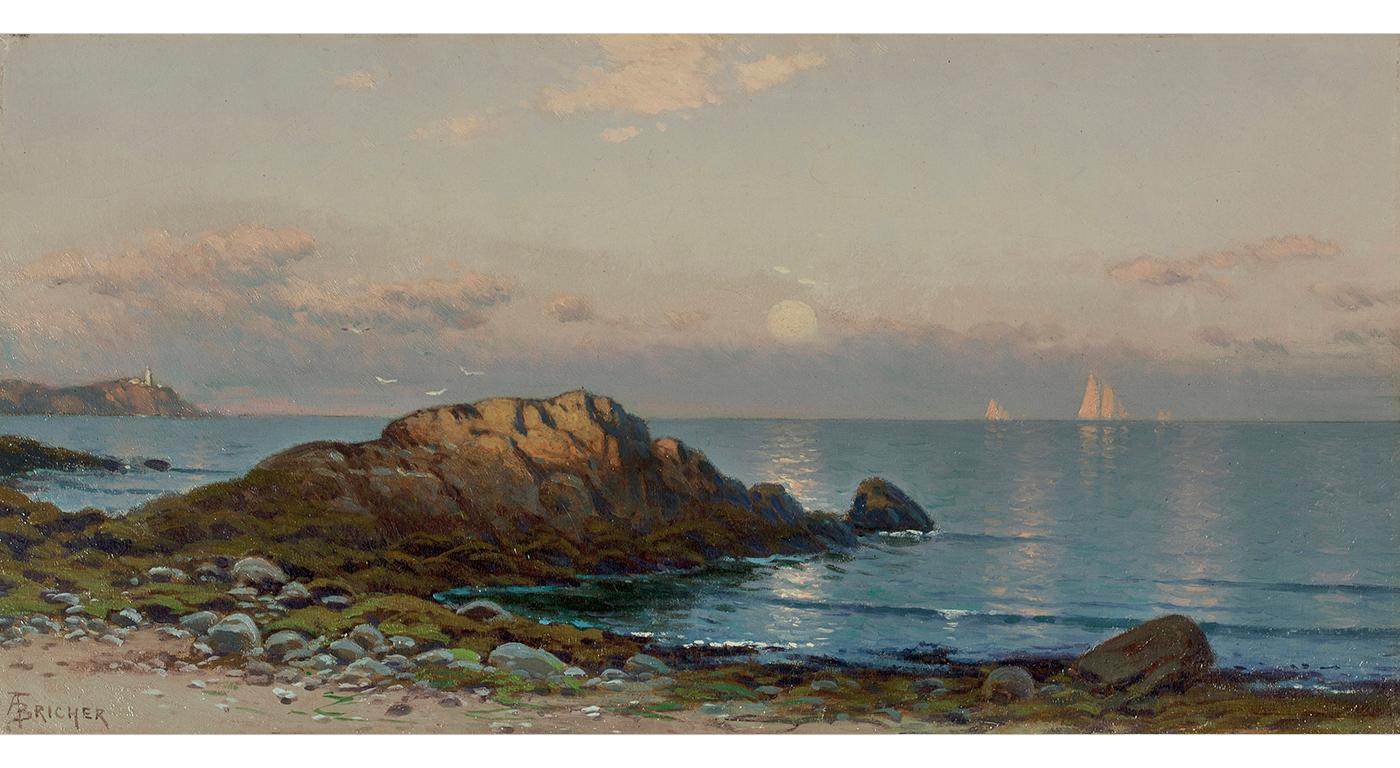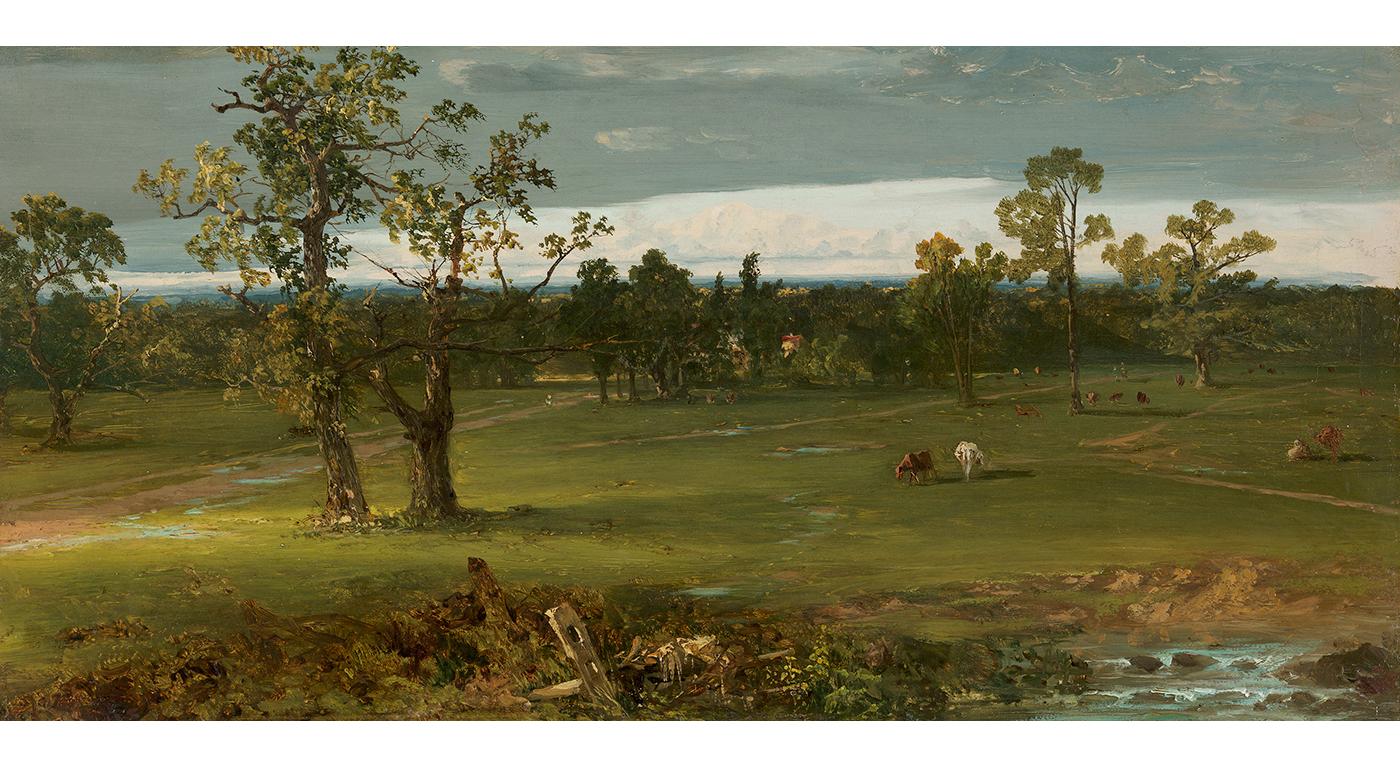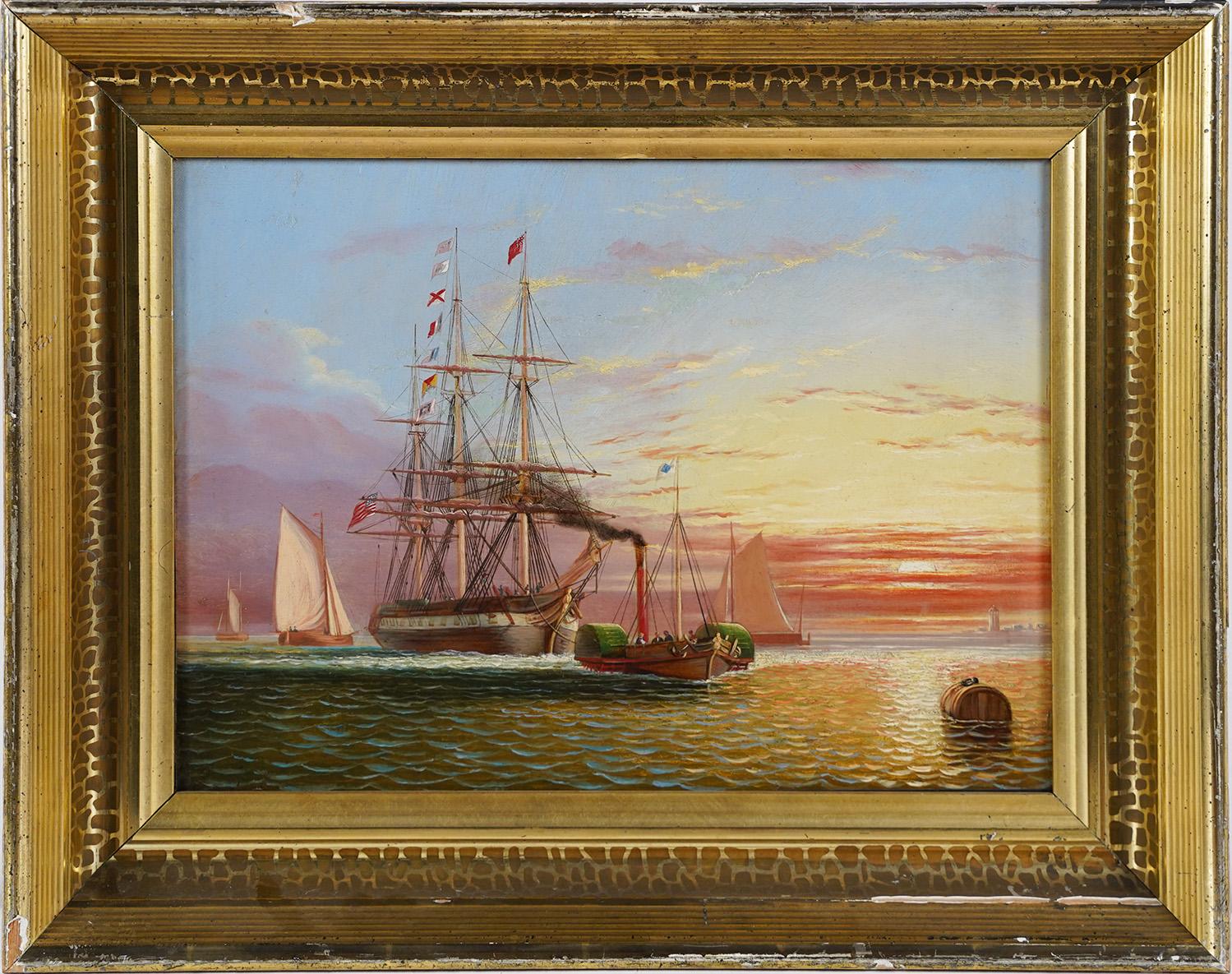Items Similar to Seascape by George Herbert McCord (American, 1848-1909)
Want more images or videos?
Request additional images or videos from the seller
1 of 8
George Herbert McCordSeascape by George Herbert McCord (American, 1848-1909)
About the Item
"Seascape," by Hudson River School artist George Herbert McCord (1848-1909) is oil on canvas and measures 18.07 x 30.13 inches. The work which comes from a private collection in Birmingham, Alabama is signed “G.H. McCord A.N.A.” at the lower left. The work is framed in a beautiful, period appropriate frame, and ready to hang.
A member of the second generation of Hudson River School painters, George Herbert McCord is known for his atmospheric landscape and marine paintings which capture a variety of locales and are executed in a variety of media—including oil, pastel, and watercolor. McCord was born in 1848 in New York City, where he lived and worked his entire life. After
1883, he kept an additional studio in Morristown, NJ. McCord traveled throughout North America, painting in the Berkshire, Adirondack and Laurentian mountain ranges, the Hudson River Valley, the Coast of New England, the Upper Mississippi, and Florida, which had become popular among Eastern vacationers. He was among a select group of artists commissioned by the Santa Fe Railroad to paint the Grand Canyon, and also participated in a special painting excursion to the Erie Canal. His travels in Europe were equally expansive, taking him to England, Scotland (having been commissioned by Andrew Carnegie to paint the scenery around his castle there), France, the Netherlands, and Italy.
McCord was well-educated, having attended Claverack College amidst the Catskills in Claverack, NY, which provided instruction in classical, French, German, English, music, painting, military, commercial, telegraphic and agricultural studies. He also studied with the accomplished painter and inventor of Morse code, Samuel F.B. Morse, and with the Scottishborn
landscape painter, James Fairman.
McCord was active in numerous art clubs and institutions in New York, including the National Academy of Design, which elected him an Associate member in 1880, the American Watercolor Society, the Brooklyn Art Club, the Salmagundi Club, and the Lotos Club. He was also a member of Artists Fund Society in Philadelphia. McCord exhibited regularly at the National
Academy and the Brooklyn Art Association, and was included in exhibitions at the Pennsylvania Academy of Fine Arts, the Boston Art Club, and the Art Institute of Chicago. McCord's great success is evidenced by his numerous awards: he received a bronze medal at the Mechanics Institute Fair in Boston in 1883, a silver medal at the New Orleans Exposition of
1885, the prestigious Shaw Prize of the Salmagundi Club in 1891, a silver medal at the Charleston Exposition of 1901, and a medal at the St. Louis Exposition of 1904. In January of 1904, his pastels of the coast of Maine, Massachusetts, New York, and England were featured in an exhibition at the Salmagundi Club. In addition to painting, McCord wrote articles on art for
the Richfield News.
Seascape is a prime example not only of McCord's talent as a painter, but as a distinctive voice in the tradition of marine and maritime painting in America. Artists' painterly focus on seascapes and ships in the second half of the nineteenth century, which had its roots in the naval traditions of the Dutch and British schools, emerged more clearly in America with the second generation of Hudson River School painters. These painters depicted the marine characteristics of the nation's
history—from maritime industries, such as shipbuilding and whaling, to the same naturalistic tendencies that turned many of their contemporaries away from representations of urban centers.
Seascape serves as a testament to this tradition as well as the meticulous skill that made McCord so highly acclaimed in his lifetime. The painting, which depicts three stately sailboats set amidst cresting waves, underscores McCord's remarkable talent not only in rendering landscape details, but also in articulating movement implicit in the sea's elemental circumstance. The rolling waves of the surf, the billowing sails of the ships, and the blow of ocean spray against the crafts' bows
are rendered in perfect detail, suggestive of the temperamental atmospheric effects of a day spent at sea.
- Creator:George Herbert McCord (1848 - 1909, American)
- Dimensions:Height: 18.07 in (45.9 cm)Width: 30.13 in (76.54 cm)
- Medium:
- Movement & Style:
- Period:
- Condition:
- Gallery Location:New York, NY
- Reference Number:1stDibs: LU2151212405362
George Herbert McCord
Known for atmospheric marine and landscape paintings in oil, pastel, and watercolor and for black and white drawings, George McCord was born in New York City and remained primarily a resident in Brooklyn although he traveled widely and from 1883 also had a studio in Morristown, New Jersey. He was part of the second generation of Hudson River School painters. He studied at the Hudson River Institute, the Claverack Academy in Claverack, New York and with Samuel Morse and James Fairman. By 1870, he was exhibiting at the National Academy of Design. He made frequent sketching trips in New England, Canada, Florida, and the Upper Mississippi and participated in one of the exclusive excursions sponsored by the Santa Fe Railroad to paint the Grand Canyon. He was also part of a special Erie Canal painting trip, and was commissioned by Andrew Carnegie to paint the scenery around his castle in Cluny, Scotland. He lived for three years in Venice and later in Paris. In 1880, he was elected an Associate of the National Academy and had many exhibitions throughout the country.
About the Seller
5.0
Vetted Seller
These experienced sellers undergo a comprehensive evaluation by our team of in-house experts.
Established in 2004
1stDibs seller since 2022
- ShippingRetrieving quote...Ships From: New York, NY
- Return PolicyA return for this item may be initiated within 14 days of delivery.
More From This SellerView All
- Woodland Waterfall by John Frederick Kensett (American: 1816-1872)By John Frederick KensettLocated in New York, NYJOHN FREDERICK KENSETT (1816-1872) Woodland Waterfall Oil on canvas 14 x 12 inches Signed lower rightCategory
19th Century Hudson River School Landscape Paintings
MaterialsCanvas, Oil
- Gordon Setter in a Landscape by Otto Norquist (American: 1859-1906)Located in New York, NYOtto Norquist (1859-1906) "Gordon Setter in a Landscape, 1890" Oil on canvas 22 x 27 inches Signed and dated 1890, lower right Otto Norquist was born in...Category
Late 19th Century Hudson River School Landscape Paintings
MaterialsOil, Canvas
- Hudson River Inlet, 1885 by American artist Frank Anderson (American: 1844-1891)By Frank AndersonLocated in New York, NYHudson River Inlet, 1885 by Hudson River School artist Frank Anderson (1844-1891) is oil on canvas. The work measures 15.13 x 24.25 inches ...Category
19th Century Hudson River School Landscape Paintings
MaterialsCanvas, Oil
- Summer by Hudson River School Artist Charles H. Chapin (American, 1830-1889)Located in New York, NYHudson River School artist Charles H. Chapin's (1830-1889) painting entitled "Summer" is oil on canvas and measures 11 x 18 inches. An inscription by the artist on the verso reads, "...Category
19th Century Hudson River School Landscape Paintings
MaterialsCanvas, Oil
- Windsor Castle by Hudson River Artist Thomas Doughty (American, 1793-1856)By Thomas DoughtyLocated in New York, NYWindsor Castle, a painting by Hudson River School artist Thomas Doughty (1793-1856) is oil on canvas and measures 17.13 x 27.63 inches. The work is signed by the artist at the lower ...Category
19th Century Hudson River School Landscape Paintings
MaterialsCanvas, Oil
- A Day in November, 1863 by James MacDougal Hart (American: 1828–1901)By James McDougal HartLocated in New York, NYA prominent 19th century landscapist, Hudson River School painter James McDougal Hart's (1828-1901) A Day in November, 1863 is oil on canvas and measures 10.5 x 18 inches. The painti...Category
19th Century Hudson River School Landscape Paintings
MaterialsOil, Canvas
You May Also Like
- Ruins with FiguresBy Jasper Francis CropseyLocated in New York, NYFamed Hudson River School painter and architect.Category
19th Century Hudson River School Landscape Paintings
MaterialsPaper, Canvas, Oil
- Moonlight SeascapeBy Alfred Thompson BricherLocated in New York, NYMonogrammed lower left: ATBRICHERCategory
19th Century Hudson River School Landscape Paintings
MaterialsOil, Canvas
- Landscape with Cows near Warwick, New YorkBy Jasper Francis CropseyLocated in New York, NYSigned and dated lower left: J. F. Cropsey / 1885Category
Late 19th Century Hudson River School Landscape Paintings
MaterialsOil, Canvas
- At PastureBy John Frederick KensettLocated in New York, NYLeading Hudson River School Painter Famous for New England ViewsCategory
19th Century Hudson River School Landscape Paintings
MaterialsOil, Canvas
- River LandscapeBy John DolphLocated in Saratoga Springs, NYJohn Henry Dolph, is best known as painter of domestic animals, especially cats. He was born in 1835 in Fort Ann, New York, and spent much of his career th...Category
19th Century Hudson River School Landscape Paintings
MaterialsCanvas, Oil
- Early Antique American School New England Sunset Sailboat Marine Oil PaintingLocated in Buffalo, NYUp for sale here is a really impressive mid 19th century painting. Very fine quality and great color! Unsigned. Framed. Image size, 13 by 17.Category
1850s Hudson River School Landscape Paintings
MaterialsOil, Canvas
Recently Viewed
View AllMore Ways To Browse
Georges B
American Seascape Paintings
Weller Hudson
George N
George F Of
Antique Seascape
Ship Seascape
Italian Seascape
Italian Art Seascape
American School Hudson River
Hudson River Painters
Hudson River School New York
Italian Seascape Paintings
Hudson Valley School
Hudson Valley School Of
Hudson Valley School Of Art
British Seascape
American School Marine






